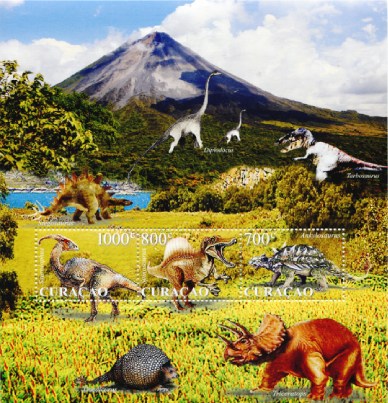Description
Prehistoric animals are all organisms that walked or swam, crawled, slithered, or flew on earth more than 5,500 years ago, before humans. Nieuwe Post with great pleasure is presenting this 3 stamp block, in honor of these creatures that represents the vast majority of extincted animals.
1000c Stamp Saurolophus means “lizard crest” is a genus of large hadrosaurine duckbill that lived about 69.5-68.5 million years ago, in the Late Cretaceous of North America (Canada) and Asia (Mongolia); it is one of the few genera of dinosaurs known from multiple continents. It is distinguished by a spike-like crest which projects up and back from the skull. Saurolophus was a herbivorous dinosaur which could move about either bipedally or quadrupedally. The crest on its head was hollow, and connected to the nasal passages, and thus could have been used to make sounds. Saurolophus could use these sounds to communicate within its herds, for example to warn of approaching predators.
800c Stamp Spinosaurus means “spine lizard” is a genus of theropod dinosaur which lived in what is now North Africa, from the lower Albian to lower Cenomanian stages of the Cretaceous period, about 112 to 97 million years ago. This genus was first known from Egyptian remains discovered in 1912 and described by German paleontologist Ernst Stromer in 1915. The original remains were destroyed in World War II, but additional material has come to light in recent years. It is unclear whether one or two species are represented in the fossils reported in the scientific literature. The best known species is S. aegyptiacus from Egypt, although a potential second species S. maroccanus has been recovered from Morocco. Spinosaurus may be the largest of all known carnivorous dinosaurs. The skull of Spinosaurus was long and narrow like that of a modern crocodilian. Spinosaurus is thought to have eaten fish; evidence suggests that it lived both on land and in water like a modern crocodilian.
700 c Stamp Ankylosaurus means “fused lizard” is a genus of ankylosaurid dinosaur, containing one species, A. magniventris. Fossils of Ankylosaurus are found in geologic formations dating to the very end of the Cretaceous Period about 66.5–65.5 Ma ago in western North America. Although a complete skeleton has not been discovered and several other dinosaurs are represented by more extensive fossil material, Ankylosaurus is often considered the archetypal armored dinosaur. Other ankylosaurids shared its well-known features, the heavily-armored body and massive bony tail club—but Ankylosaurus was the largest known member of the family.




